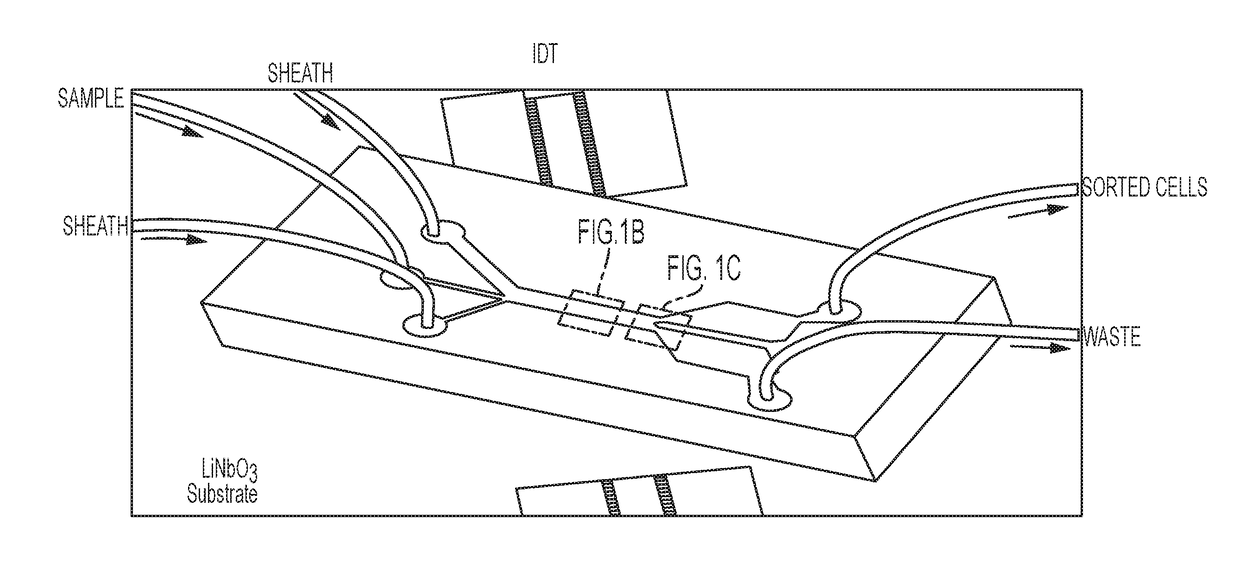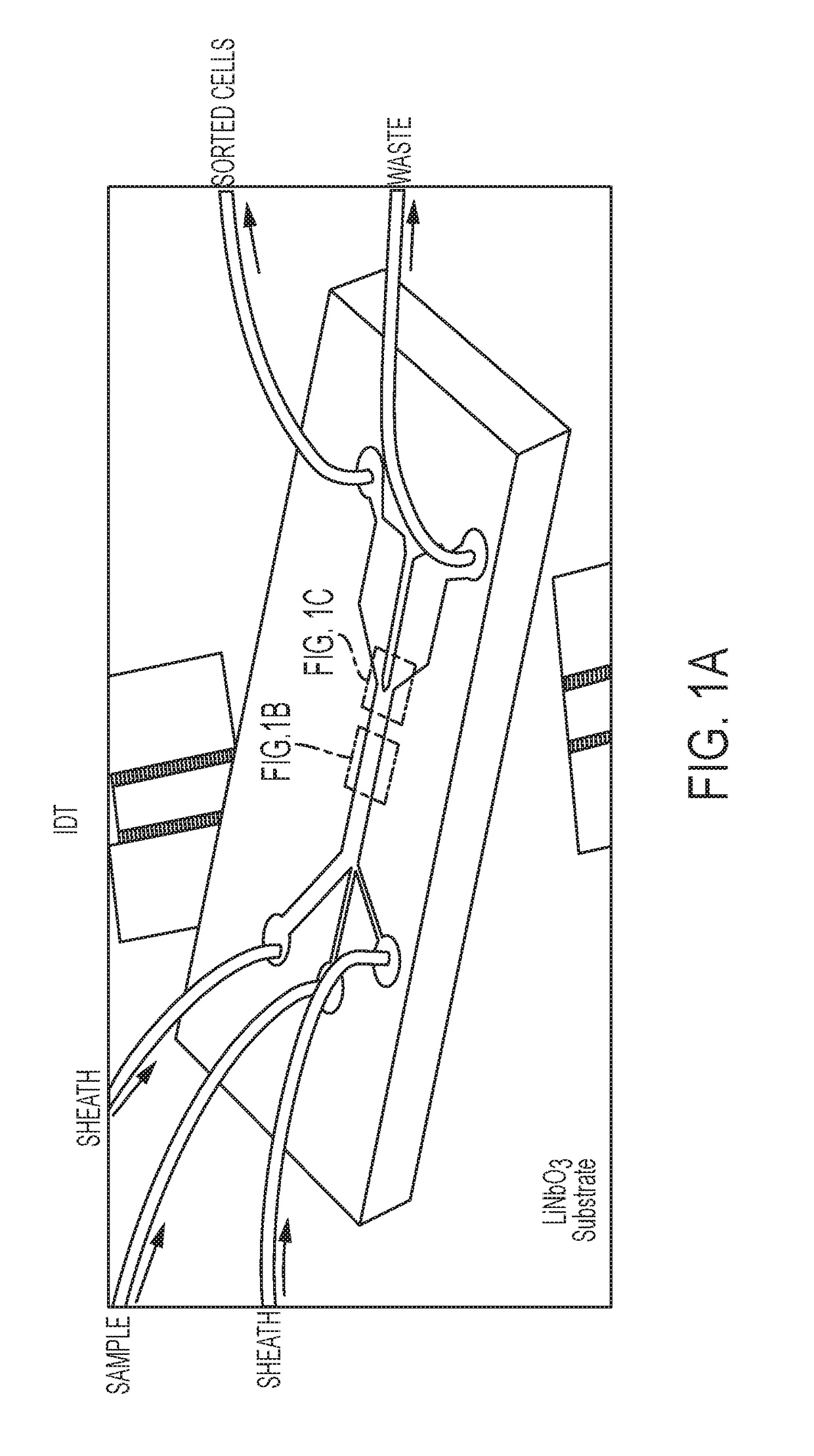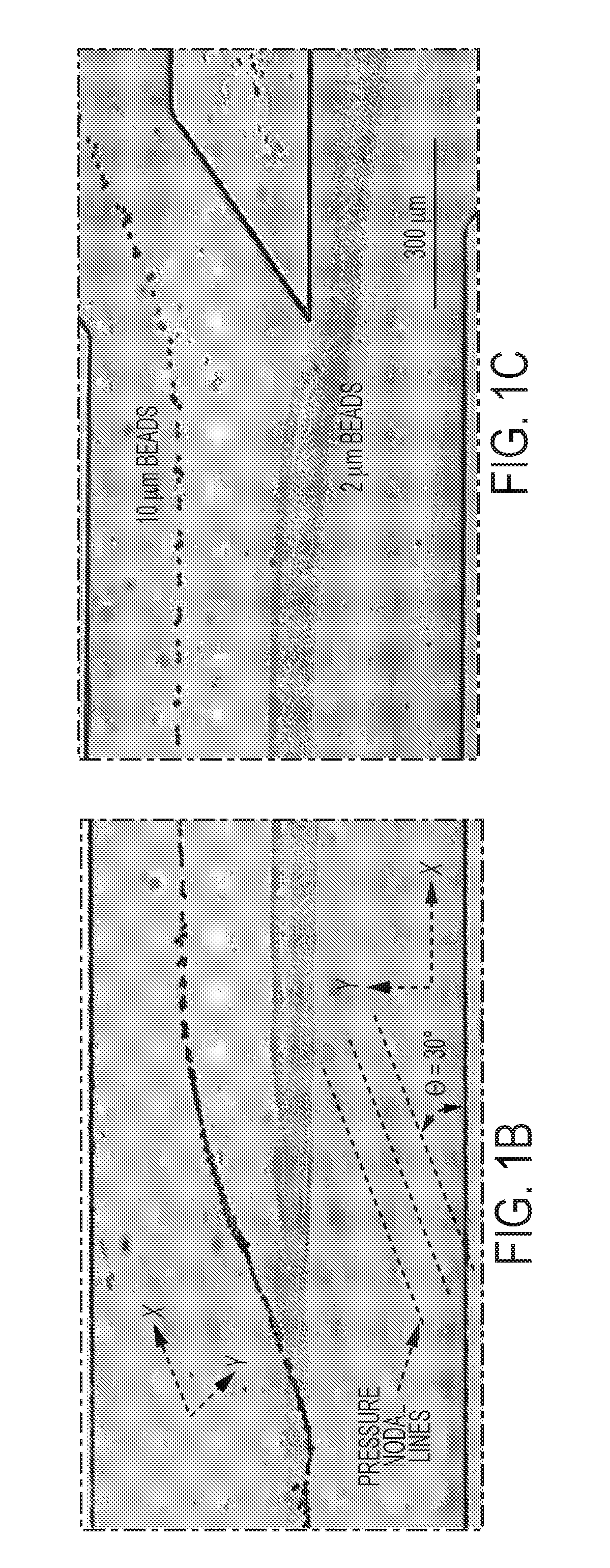Separation of low-abundance cells from fluid using surface acoustic waves
a technology of surface acoustic waves and low-abundance cells, which is applied in the field of low-abundance cells from fluid using surface acoustic waves, can solve the problems of low separation sensitivity and efficiency, and the acoustic separation has not been widely used in cell separation applications. achieve high cell viability and integrity, and improve separation efficiency
- Summary
- Abstract
- Description
- Claims
- Application Information
AI Technical Summary
Benefits of technology
Problems solved by technology
Method used
Image
Examples
example 1
Cell Separation Using Tilted-Angle Standing Surface Acoustic Waves
Design and Characterization
[0074]FIG. 1, Panel A illustrates the structure and the working mechanism of the tilted-angle standing surface acoustic wave (taSSAW) separation device. A polydimethylsiloxane (PDMS) microfluidic channel was bonded in between a pair of identical interdigital transducers (IDTs) coated on a piezoelectric substrate. The microfluidic channel consists of three inlets and two outlets. The pair of IDTs were deposited in a parallel arrangement with respect to each other, and aligned at a specific angle with respect to the channel and flow direction. A radio frequency (RF) signal was imposed at each IDT to generate two identical surface acoustic waves (SAWs). These two SAWs propagate toward each other and interfere to form a SSAW in between the IDTs located within the PDMS microchannel. Such a SSAW generates parallel pressure nodal and anti-nodal lines at a particular angle to the flow direction, and...
example 2
Separation of Low-Abundance Cancer Cells from Human Blood Using Surface Acoustic Waves
[0119]Cancerous cells presenting in the blood flow are called circulating tumor cells (CTCs). CTCs carry important information related to disease progression and prognosis. It opens up the opportunity to examine and study cancer progress with a more non-invasive manner (blood drawing). However, it is extremely challenging to isolate CTCs from blood sample due to the scarcity of CTCs (1-100 cancer cells in one mL of blood).
[0120]This invention presents, for the first time, the separation of human cancer cells from human white blood cells using surface acoustic wave technologies (FIG. 13). It is also the first report of acoustic-based separation of rare cancer cells from human blood (<1000 cancer cells per ml blood) which maintains high cell viability and integrity. The ability to preserve cell viability and integrity is significant for downstream analysis. With its ability to achieve high-efficiency...
example 3
Separation of Cells and / or Particles Using Segmented Interdigital Transducers (S-IDTs)
Microfluidic Device
[0123]As shown in FIG. 18, Panel A, to generate standing surface acoustic waves (SSAW), a pair of interdigital transducers (IDT) is deposited on a piezoelectric substrate (LiNbO3). A polydimethylsiloxane (PDMS) based microfluidic channel is bonded onto the substrate with three inlets (two sheath flows and one sample flow) and two outlets. The size of the device is slightly larger than a penny.
[0124]Instead of using the regular parallel IDTs, a pair of segmented IDTs (S-IDT) were used. As shown in the inset of FIG. 18, Panel A, a S-IDT consists of many small sections of parallel IDTs. Each section has a consistent displacement from the previous one in the lateral direction. The function of a S-IDT is to generate many discontinued, independent SSAW fields in the fluidic channel along the flow direction. Each field has a certain phase shift from the previous one as shown in FIG. 18,...
PUM
| Property | Measurement | Unit |
|---|---|---|
| flow rate | aaaaa | aaaaa |
| angle | aaaaa | aaaaa |
| angle | aaaaa | aaaaa |
Abstract
Description
Claims
Application Information
 Login to View More
Login to View More - R&D
- Intellectual Property
- Life Sciences
- Materials
- Tech Scout
- Unparalleled Data Quality
- Higher Quality Content
- 60% Fewer Hallucinations
Browse by: Latest US Patents, China's latest patents, Technical Efficacy Thesaurus, Application Domain, Technology Topic, Popular Technical Reports.
© 2025 PatSnap. All rights reserved.Legal|Privacy policy|Modern Slavery Act Transparency Statement|Sitemap|About US| Contact US: help@patsnap.com



